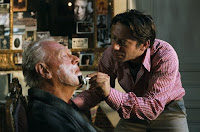Thursday entry: Passed Lives


A couple of days ago I was able to share a clip of “The Diving Bell and the Butterfly” in my film class. Each student has a designated day for sharing so everybody gets a turn. The main character, Jean-Dominique Bauby, had suffered from a severe stroke that left him paralyzed. His experience is brilliantly simulated by the camera; through the use of selective focus, it is apparent that he is struggling with vision and limited to the stagnant view that his heavy head can provide. The scenes that appear cinematic and show more control tend to only be his dreams. Within the first five minutes of the movie, he awakes from his coma in a hospital bed only to discover that the thoughts and words he uses to form sentences in his head are incongruous to the sounds and the motions that come from his mouth. Sometimes, the scene will jump between different environments; other times the screen fades to black, and when Bauby awakes, a slight change in the composition (like flowers by the windowsill) becomes the only indication that time has passed. This camera style of the first person point-of-view is slightly nauseating, but after the shock of his paralysis begins to fade and he accepts his condition, he is more willing to attempt communication, which makes him stable. In turn, the camera’s movements are refined and the transitions between scenes are less chaotic.
His desire for communication and to be understood during a time when he did not have the motivation to recover seemed like one weighty aspiration, almost too ambitious. The frustrations of being restricted in some way can accumulate into a deadly knot, but I feel the ability of dreaming and the imagination is what helped him through the first stages of realizing he was immobile. Despite any physical limitations, his mind is essentially what kept him moving and what kept him alive. I like the idea of being able to express strong emotions in a reserved way. In the case of paralysis, we are not given the opportunity to read a subject’s facial expression or body language to determine mood. Instead, we are forced to read the environment and beg for the generosity of context clues. I am interested in creating my own limitations within portraits, so that the subjects are forced to find another way of communicating emotion.

Comments
Post a Comment